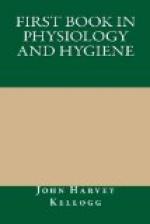12. Effects of Tobacco on the Heart and the Blood.—When a boy first tries to use tobacco, it makes him feel very sick. If you should feel his pulse just then, you would find it very weak. This means that the heart is almost paralyzed by the powerful poison of the tobacco. Tobacco also injures the blood corpuscles.
13. Tea and coffee also do their share of mischief to the heart. Those who use them very strong often complain of palpitation, or heavy and irregular beating of the heart.
14. Taking Cold.—People usually “catch cold” by allowing the circulation to become disturbed in some way, as by getting the feet wet, being chilled from not wearing sufficient clothing, sitting in a draught, and in other similar ways. It is very important for you to know that a cold is a serious thing, and should be carefully avoided.
15. Hemorrhage (hem’-or-rhage) or Loss of Blood.—A severe loss of blood is likely to occur as the result of accidents or injuries of various sorts, and it is important to know what to do at once, as there may not be time to send for a doctor before it will be too late to save the injured person’s life. Here are a few things to be remembered in all such cases:
16. If the blood from a cut or other wound flows in spurts, and is of a bright red color, it is from an artery. If it is dark-colored, and flows in a steady stream, it is from a vein.
17. How to Stop the Bleeding of Wounds.—If the bleeding vessel is an artery, apply pressure on the side of the wound next to the heart. If the bleeding is from a vein, apply it on the opposite side. It is generally best to apply pressure directly over the wound or on both sides. The pressure can be made with the thumbs or with the whole hand. Grasp the part firmly and press very hard, or tie a handkerchief or towel around the wounded part and twist it very tight. If an arm or limb is the part injured, the person should be made to lie down, and the injured part should be held up. This is of itself an excellent means of stopping hemorrhage.
18. Nose-Bleed.—For nose-bleed a very good remedy is holding one or both hands above the head. The head should be held up instead of being bent forward, and the corner of a dry handkerchief should be pressed into the bleeding nostril. It is well to bathe the face with very hot water, and to snuff hot water into the nostril if the bleeding is very severe. If the bleeding is very bad or is not readily stopped, a physician should be called.
SUMMARY.
1. Violent exercise is likely to injure the heart.
2. Bad air makes the blood impure and disturbs the action of the heart.
3. Unwholesome food produces bad blood.
4. Too little sleep makes the blood poor.
5. Proper clothing is necessary to make the blood circulate equally in different parts of the body.




